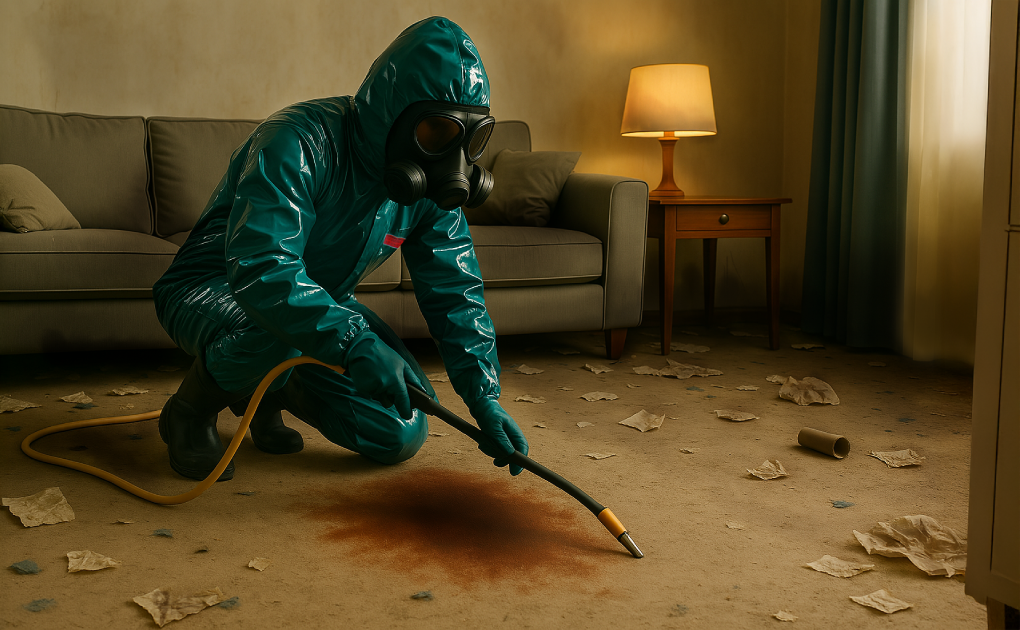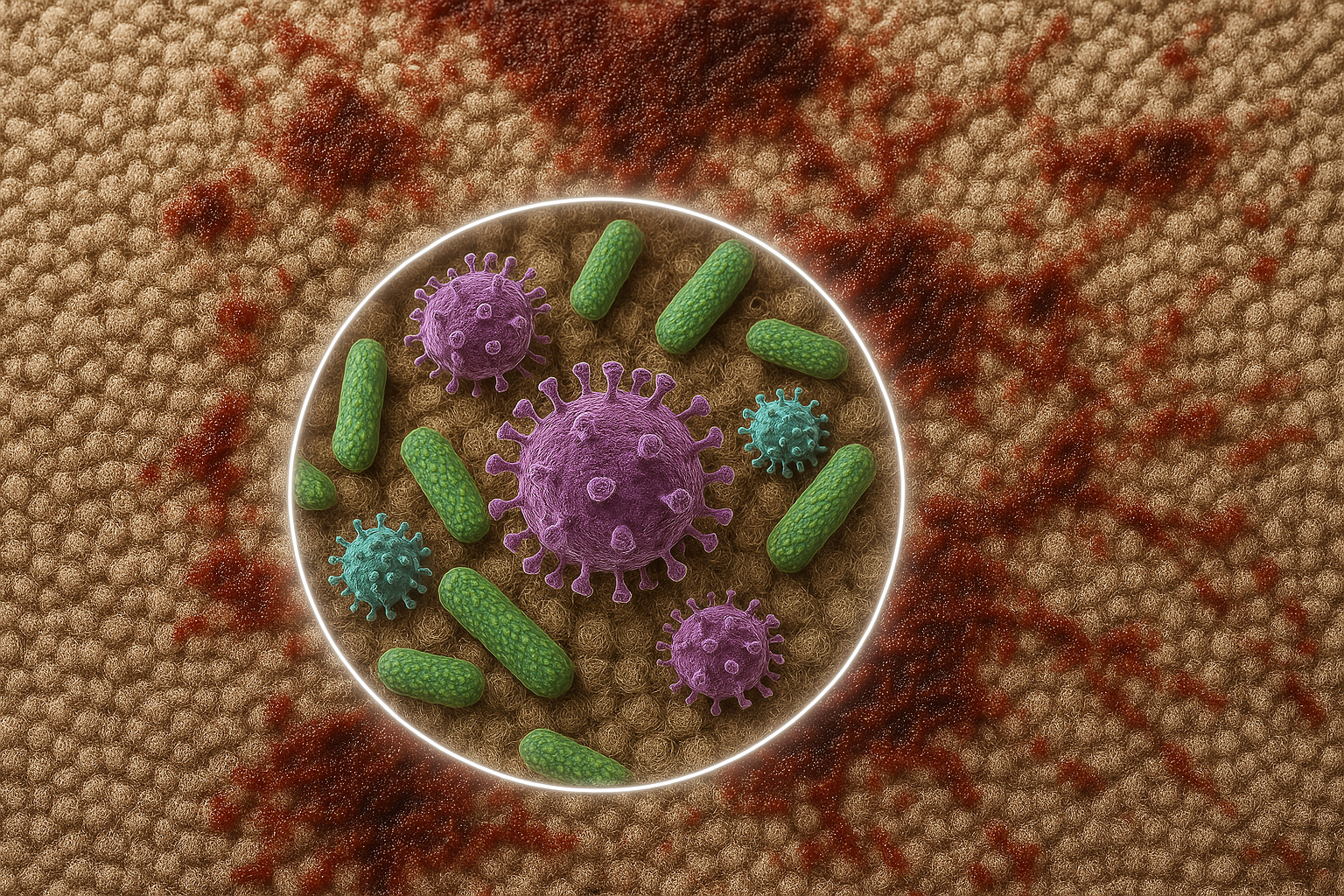
Crime scene cleaners in action: what PPE really needs to do here
Between grey areas & dangers: What crime scene cleaners actually cope with
They arrive when the job ends for others. When the blue lights have long since gone out and the forensics have been completed – and what remains is a place that nobody enters voluntarily. Crime scene cleaners enter rooms full of stories. Stories of loss, violence, loneliness or tragic fates. But apart from the emotional strain, their work is one thing above all: a job with the highest standards of hygiene, responsibility and personal protective equipment.
Because what on the surface appears to be a cleaning job is actually highly sensitive work at the interface between infection control, hazardous substance disposal and psychological stress. Crime scene cleaners are not actors in crime series – they are specialists who act with medical seriousness and technical expertise. In contaminated homes, places where bodies have been found or places with biological hazards, every detail counts – especially the right PPE.
Whether blood, body fluids, decomposed tissue, bacteria or viruses: physical contact with these substances can be life-threatening. A little carelessness – and the risk of hepatitis, HIV or multi-resistant germs increases rapidly. This is where the crisp marketing claims prove themselves in the reality of PPE. We need equipment that protects under extreme conditions – reliable, comfortable and well thought-out.
In this article, we take a look behind the scenes of an industry in which safety is non-negotiable – and show why protective clothing cannot be a compromise in crime scene cleaning.

Invisible risks: What dangers lurk at crime scenes
When you think of crime scene cleaning, you often have images of destroyed furniture, shattered glass or blood-stained carpets in your head. But the real dangers usually remain invisible: hazardous biological substances, aerosols, pathogens and contaminated materials. Crime scenes are often breeding grounds for a whole range of risks that cannot be recognised at first glance. Residues of bodily fluids, faeces or tissue decompose in a very short time. This produces bacteria, fungi and gases that not only smell unpleasant but are also hazardous to health. A small cut on the finger, an unprotected breath - and there is already the possibility of coming into contact with highly infectious pathogens:
- Hepatitis B & C
- HIV
- MRSA and other resistant germs
- Enteroviruses, noroviruses and other gastrointestinal pathogens
The situation becomes particularly critical if the sites of use have remained undetected for a long time - such as in the case of corpses that are only reported weeks later. Here, not only cadaver toxins and bacterial decomposition products are formed, but also aggressive aerosols that spread through the air in the room.
In addition, there is the psychological stress caused by the extreme environment: the odour, the confinement, the knowledge of what has happened. These factors also increase the risk of errors - and make functional, comfortable and well thought-out PPE all the more important.
What counts here:
- Maximum possible protection against liquids & particles
- Protection against biohazards in accordance with protection class type 5B/6B
- Antistatic features & low-lint material
- Ergonomics and wearing comfort - especially for long periods of use
Because there is no time for doubt at the crime scene: the protective equipment has to work - at the first moment, throughout the operation, with every step.
Scenarios of use: When is crime scene cleaning necessary?
Crime scene cleaners are always deployed when conventional cleaning methods are no longer sufficient. Their demanding field of work begins wherever biological residues, infection risks or psychologically stressful situations occur. This ranges from suicides and undiscovered deaths to violent crimes, neglected flats or accident sites with a risk of contamination.
Although spectacular criminal cases are often the focus of media attention, in reality it is usually more everyday but no less challenging scenarios that require professional crime scene cleaning. The locations are often subject to high levels of health and emotional stress - and place high demands on hygiene, discretion and personal protective equipment.
Situations involving hazardous biological substances, bodily fluids or decomposed tissue residues in particular require specialised cleaning with strict safety precautions. The aim is not only to clean, but also to reliably eliminate health risks - for relatives, landlords and future residents.
PPE for extreme cases: what requirements a protective suit must fulfil
Crime scene cleaning is not about symbolism - it's about substance. Personal protective equipment (PPE) must not only provide protection in theory, but also withstand the extreme conditions of the job: Heat, movement, wetness, prolonged wear, mental stress and the risk of contamination at every turn.
A simple overall is not enough. What is needed is a protective suit that has been proven to protect against biological agents, is permeable to air and liquids, but at the same time does not allow particles or liquids to pass through.
Practical example of standard-compliant safety: The CoverStar® CS500 in crime scene use
The protective suit CoverStar® CS500 from ASATEX has been specially developed for situations in which biological risks, liquid splashes and hygiene standards place the highest demands.
The PPE for crime scene cleaners must be assigned to at least PPE category III - i.e. protection against fatal or irreversible health risks.
Particularly relevant are:
• EN 14126 – Protection against infectious agents (biohazards)
• EN ISO 13982-1 Type 5B – Protection against solid, biological particles
• EN 13034 Type 6B – Protection against light liquid splashes (blood, secretions)
• EN 1149-5 – Antistatic (especially in contaminated, dusty environments)
Technical details that protect lives
• Glued seams instead of tight seams
• Double zip fastener covers
• Thumb loops & Elasticated leg cuffs for a secure fit - Low-linting - High level of comfort & freedom of movement Ergonomics; elasticated leg cuffs for a secure fit
• Low-lint material
• High wearing comfort & Freedom of movement
Ergonomics: The often underestimated safety factor
An ill-fitting suit that pinches or slips is unknowingly worn incorrectly – and that increases the risk. That's why the ergonomics of the CoverStar® CS500 are also part of its safety performance. Whether it's zip fasteners, elasticated waistbands or a hood that can be combined with a respirator, the interaction of all components is crucial.
Operation under extreme conditions: Decomposition, odour pollution & aftercare
The requirements for protective suits increase significantly in particularly demanding areas of application - such as where bodies are found after a long period of time, decomposition or severely neglected homes. In addition to protection against biological agents, it is also important to prevent odours from penetrating clothing.
In such cases, gas-tight or particularly odour-resistant protective suits are often used. One example from the ASATEX range is the CoverChem® CP500, which impresses with its high barrier effect against liquids and particles - and is also particularly robust.
Washable protective suits are considered a sustainable solution by some users. However, they quickly reach their limits when it comes to crime scene cleaning: they can only be washed at low temperatures (often 30 °C), are not always 100% decontaminable and can retain odours. This is why disposable protective suits are favoured in the industry:
Advantages of disposable protective suits:
- No spread of germs
- Immediate special disposal
- No cleaning effort
- No odour residues
- Psychological relief for cleaning staff
- Constant, tested protective effect
In many cases, the actual cleaning of the home is followed by a complete clear-out and disinfection. The PPE used for this must also be robust, flexible and ergonomic.
Conclusion: Crime scene cleaning is risk management – with system and responsibility
Crime scene cleaning requires much more than just good nerves. It is a highly specialised field in which hygiene, protection and mental resilience go hand in hand. Choosing the right PPE is not a minor matter, but an elementary component of professional occupational safety. ASATEX supports cleaning professionals with certified, practical protective clothing that makes all the difference. For safe workplaces, healthy returners and real protection when it matters most.
